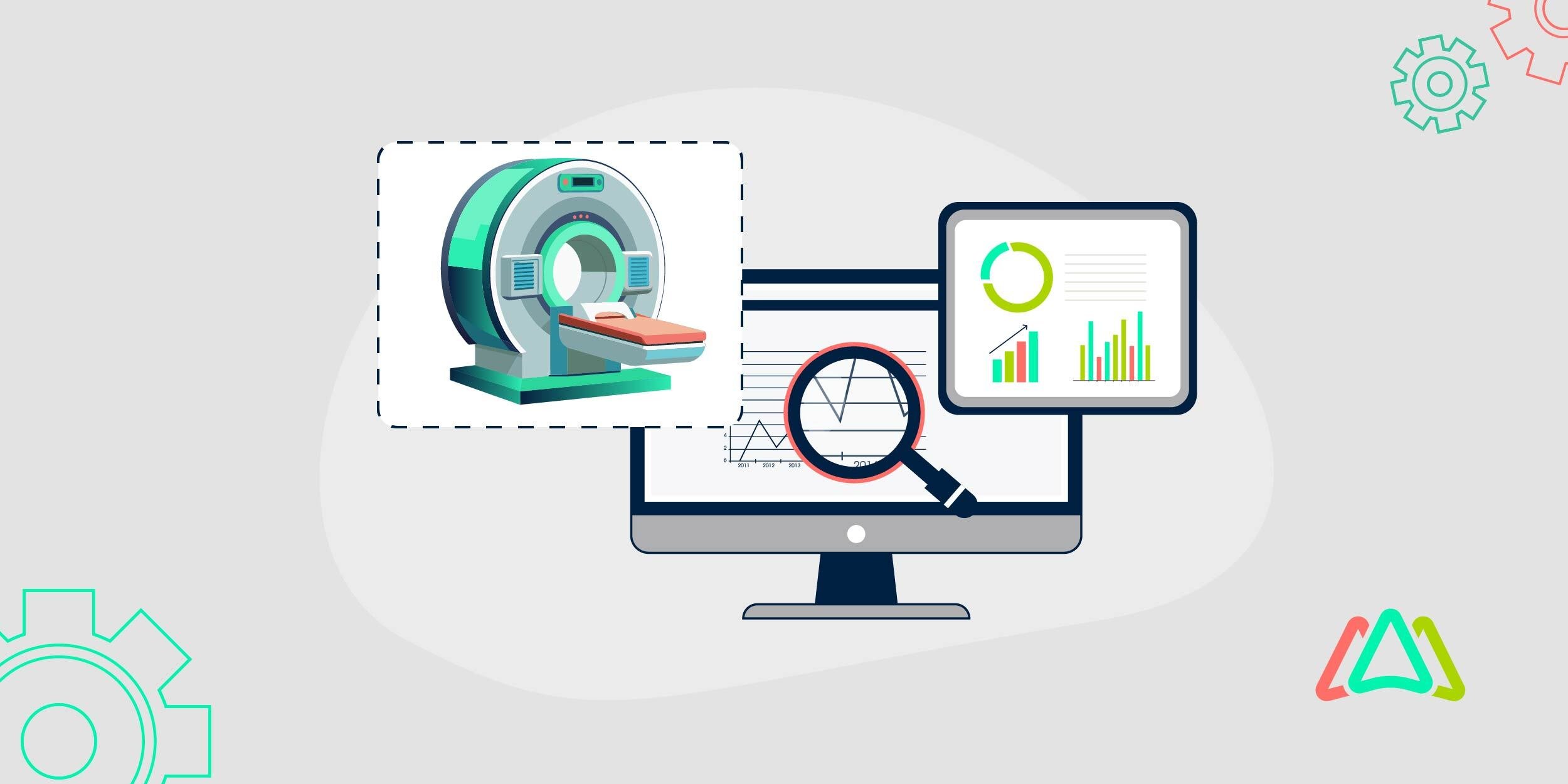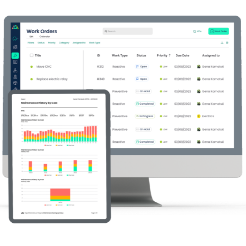
CMMS Software Enabled AEM Program
Today’s maintenance operations have become more complex and sophisticated. Gone are the days of using paper and pen, sticky notes, and filing work orders in filing cabinets. Today, maintenance managers—especially those in healthcare, manufacturing, and large facilities—are under pressure to do more with less while still maintaining compliance and safety. To answer this challenge, they need a much better maintenance solution.
That’s where AEM or Alternative Equipment Maintenance programs come into play. These strategies allow organizations to step away from original equipment manufacturer (OEM) maintenance recommendations only when data shows it's safe and practical to do so. However, a successful AEM program doesn’t rely on spreadsheets and guesswork, as previously suggested. Instead, it requires the structure and reliability of a modern CMMS (Computerized Maintenance Management System) to ensure success. This article explores how CMMS software supports an organization’s initiatives to implement an AEM program that is compliant, efficient, and data-driven. The article reviews how to structure an effective CMMS-based AEM program, ensuring:
- Safety & performance remain intact.
- Regulatory compliance is well-documented
- Operational efficiency is maximized.
What is a CMMS?
A Computerized Maintenance Management System (CMMS) is software designed to streamline maintenance operations. Simply put, it holds asset data, schedules preventive actions, tracks work orders, and manages parts inventory. This helps facilities reduce downtime, cut costs, and make data-driven decisions. The software is widely used across a wide range of industries, including manufacturing, healthcare, education, and public services. Its strength lies in transforming maintenance operations from being reactive to preventive, including predictive, using IoT and other measuring devices.
What is AEM?
On the other hand, Alternative Equipment Maintenance (AEM) is a strategic, data-driven alternative to strictly following OEM schedules or calendar-based preventive maintenance schedules. This approach is beneficial for older, low-risk, or non-medical equipment. AEM programs adjust maintenance frequencies based on equipment’s actual usage, failure history, and risk profile, yielding cost and resource efficiencies while maintaining safety. Evidence-based deviations enable better allocation of labor and budget by focusing resources where they’re truly needed, often extending asset life while maintaining safety and compliance. By tailoring maintenance to real-world usage, organizations can reduce unnecessary tasks and improve overall operational efficiency.
In healthcare, AEM programs are increasingly sought after to manage legacy infrastructure—such as HVAC, plumbing, and utility assets—where manufacturer guidance may be missing or outdated. The program’s value is recognized by regulatory bodies, including CMS and AAMI, which formally permit deviations from OEM PM under structured AEM when completed with proper risk analysis and documentation.
Why Pair CMMS with AEM?
The following are specific advantages of integrating an AEM program with a modern CMMS:
- Centralized data & traceability: All asset histories, risk assessments, and justification for deviating PM schedules are stored in one authoritative system. These are critical data points necessary for audits or compliance checks.
- Evidence-based decision-making: CMMS analytics lets maintenance teams analyze asset performance, track failure trends, and make informed adjustments to maintenance protocols.
- Increased regulatory confidence: Structured documentation in hand, such as failure codes, downtime, and review comments, helps support AEM decisions for bodies like CMS or The Joint Commission.
The Role of CMMS in AEM
A CMMS plays a central role in documenting, analyzing, and monitoring an Alternative Equipment Maintenance (AEM) program. A CMMS is necessary because without its structured system in place, it is nearly impossible to maintain the level of detail, consistency, and traceability required to support AEM compliance, especially in highly regulated industries like healthcare. CMMS software serves as the single source of documentation for maintenance records, capturing essential data about assets, work orders, procedures, and risk classifications. It is responsible for streamlining internal processes and also ensures organizations are prepared for audits by regulatory bodies such as The Joint Commission and the Centers for Medicare & Medicaid Services (CMS).

One of the most noteworthy aspects of a CMMS in an AEM program is its ability to collect and track identified key data fields. For example, within a CMMS’s work order feature, fields such as PM Preventable, Failure Code, Downtime Impact, and Failure Effect help teams analyze whether preventive maintenance tasks are reducing equipment failures or downtime. On the equipment side, fields such as AEM inclusion status, risk classification, in-service date, manufacturer recommendations, and justification for deviation allow users to build a transparent, supported case for each AEM decision. A CMMS supports the analytical rigor required to maintain a safe and effective AEM program by ensuring these fields are consistently completed and updated.
Another critical function of CMMS sofwtare is its ability to store both the original manufacturer guidelines and the modified AEM procedures. Organizations have the option of attaching PDFs or scanned documents directly to asset records or archiving legacy PM procedures in the system for comparison. A high level of documentation, such as this, is essential when demonstrating that AEM decisions are instead supported by a history of performance data and expert review and not made arbitrarily. An added feature is CMMS’s ability to be configured to deactivate or hide unused PM schedules while preserving their records. Doing so creates a transparent audit trail for all maintenance decisions.
Finally, a CMMS helps support a continuous review process, which is critical in any successful AEM program. With built-in analytics and reporting tools, maintenance teams can track metrics like mean time between failures (MTBF), technician observations, equipment downtime, and maintenance costs. Having this capability helps maintenance leaders identify when an AEM procedure needs to be re-evaluated or adjusted based on emerging trends. Some CMMS platforms also have the added benefit of inputting log reviewer names, credentials, and justification notes directly within the asset or procedure record, further reinforcing the defensibility of the AEM strategy. All of these capabilities considered ensure that the AEM program remains evidence-based, flexible, and responsive to operational needs.
Implementation Challenges & Solutions
Whenever a new program is introduced, anticipating a few challenges is normal. The same is true when integrating an AEM program into a CMMS. One of the most common hurdles is overcoming resistance to change, particularly among technicians and leadership accustomed to following OEM-recommended preventive maintenance schedules. Making the shift from a time-based or manufacturer-guided model to a data-driven, risk-based approach requires both a mind shift and a cultural shift. To do this effectively, it takes time, training, buy-in and patience. Beyond this issue, many organizations find themselves struggling with inconsistent or incomplete data in their CMMS. Faulty data found in equipment histories, failure codes, or risk classifications makes it challenging to justify AEM decisions or monitor their effectiveness. Some regulatory limitations need to be considered. For example, CMS prohibits certain critical equipment types—like lasers, imaging devices, or life-support systems—from being included in AEM programs. Limitations such as these need to be identified and communicated to maintenance teams to avoid unnecessary confusion.
The solution to minimizing these challenges lies in building a solid foundation before the AEM program launch. To begin, team members need to be briefed by leadership on the benefits of AEM, including support for the policy change, training, and incentives. Technicians need to be educated not just on how to use the CMMS, but on the importance of accurate documentation. Organizations should also invest time in standardizing CMMS data fields and ensuring clean, consistent asset records. Risk assessments must be methodical and well-documented, and follow the guidelines established by AAMI or other accrediting bodies.
Additionally, sharing early wins from integrating an AEM program into a CMMS can motivate and build confidence among team members. This can be easily accomplished using CMMS reporting tools. By tackling implementation proactively, thoughtfully and collaboratively, organizations can minimize and overcome these barriers, creating a defensible, efficient AEM program that withstands both internal scrutiny and regulatory audits.
Choosing the Right CMMS for AEM
Selecting the right CMMS is a critical first step in successfully implementing and sustaining an AEM program. While the CMMS marketplace offers a wide range of CMMS solutions, not all CMMS platforms provide the flexibility and depth of functionality required to support the documentation, risk assessment, and audit readiness that AEM requires. The ideal CMMS system should be highly customizable, allowing users to tailor asset records with fields for AEM inclusion status, risk classification, review history, and deviation rationale. It should also support the attachment of supporting documentation (like original OEM procedures and modified AEM schedules), provide workflow tools for review and approval, and include robust reporting features to track performance trends such as failure rates and mean time between failures (MTBF).
In addition to these technical capabilities, a suitable CMMS should align with the specific needs of your industry. For example, healthcare organizations should prioritize systems with built-in compliance tools for CMS and Joint Commission reporting. On the other hand, manufacturers might seek CMMS platforms that integrate with production systems or IoT sensors. A user-friendly interface, mobile accessibility for technicians, and reliable vendor support are also important considerations. The bottom line is, a CMMS that supports data transparency, consistent documentation, and performance analysis will not only simplify AEM implementation, but it will strengthen the program’s defensibility and impact over time.
Step-by-Step Implementation Best Practices
An AEM program that can ensure safety, regulatory compliance, and operational efficiency is best achieved by following best practices during implementation. Utilizing a structured, evidence-based approach as the one outlined below helps organizations avoid costly mistakes, justify deviations from OEM recommendations, and establish a defensible program that withstands audits and internal scrutiny.
- Gain executive sponsorship
Securing leadership buy-in is crucial for effective resource allocation and long-term success. Additionally, executives can play a vital role in removing organizational barriers, prioritizing the initiative, and reinforcing its importance across all departments. - Audit current work order & asset data
Before launching an AEM program, assess the quality and completeness of existing CMMS records. Identify gaps in documentation, inconsistent coding, or outdated asset information that could undermine risk assessments. These steps will prevent data inaccuracies that potentially have a considerable bearing on the effectiveness of the AEM program. - Configure CMMS fields and workflows
Customize your CMMS to include required fields for AEM participation, risk scoring, failure effects, and reviewer notes. Set up workflows for reviewing and approving AEM-related changes to ensure accountability and traceability. - Train stakeholders (techs, engineers, compliance)
Educate all team members involved on AEM principles, regulatory boundaries, and how to document maintenance activity in the CMMS accurately. A well-informed staff is fundamental to maintaining high-quality data and defensible decisions.

- Launch pilot AEM on select asset groups
Begin by testing your AEM framework on a manageable group of non-critical assets. This allows you to refine your approach, identify errors, correct issues, and build confidence before scaling up. - Monitor outcomes & adjust
Use CMMS reports to track performance metrics like failure rates, PM effectiveness, and downtime. Analyze the results regularly and fine-tune your AEM program to address emerging trends or unforeseen risks previously not identified. - Scale out program and document continuously
Once the pilot test run has proven effective, expand your AEM strategy to additional asset groups. Continuous improvement, backed by transparent recordkeeping, will ensure long-term success and regulatory compliance using the AEM program.
Final Thoughts
A successful AEM program involves a lot more than simply adjusting maintenance schedules. Most notably, it requires disciplined planning, thorough documentation, and continuous monitoring, all made possible through integration with a well-configured CMMS. By leveraging the full capabilities of your CMMS, you can create a centralized, transparent system for capturing asset data, tracking performance trends, and justifying every decision tied to AEM. Beyond reducing unnecessary preventive maintenance, it also improves resource allocation, minimizes equipment downtime, and reinforces compliance with regulatory standards.
Through effective implementation, an AEM strategy powered by a CMMS empowers team leaders to make smarter, data-driven decisions about maintenance. It transforms what could be a risky deviation from manufacturer guidance into a carefully managed, performance-based program. By utilizing the right tools, workflows, and team alignment, organizations can confidently implement AEM programs that enhance efficiency while maintaining the highest regulatory standards of safety and accountability.
TABLE OF CONTENTS
Keep Reading
Spare parts management within maintenance can make the difference between a problem-free ...
16 Dec 2025
Every maintenance team eventually faces the same question: When should we repair, and when ...
12 Dec 2025
Enterprise Asset Management (EAM) software has become a cornerstone for organizations aiming ...
12 Dec 2025
Unexpected equipment breakdowns can disrupt operations, increase repair costs, and reduce ...
11 Dec 2025
Businesses are always looking for ways to improve efficiencies, reduce costs, and improve ...
9 Dec 2025
The longest U.S. federal government shutdown to date lasted 43 days, beginning on October 1, ...
5 Dec 2025
Every maintenance professional faces it sooner or later — that critical time when an aging ...
18 Nov 2025
The term 'best' is often used loosely, without a clear understanding of its context or ...
14 Nov 2025
In the not too distant past, maintenance strategies have been defined by reaction—fixing ...
13 Nov 2025
Tax season is the time of year that often sends a ripple of anxiety through many of us. The ...
11 Nov 2025
Selecting a Computerized Maintenance Management System (CMMS) can, at first glance, be an ...
4 Nov 2025
In healthcare facilities, equipment uptime involves more than achieving operational ...
31 Oct 2025
Companies are subject to economic ups and downs, also known as economic volatility. Today, ...
30 Oct 2025
Maintenance challenges are a constant struggle, with unplanned downtime costing manufacturers ...
27 Oct 2025
Last winter, a maintenance technician at a U.S. paper mill ignored a predictive alert that ...
10 Oct 2025
Many organizations proudly say they “have a CMMS,” but ownership alone doesn’t equal ...
9 Oct 2025
Every maintenance team is under pressure to do more with less. Unplanned downtime is often ...
7 Oct 2025
The implementation of simple, yet powerfully effective, checklists has repeatedly ...
3 Oct 2025
In manufacturing, every second counts. When production stops, whether due to scheduled ...
2 Oct 2025
The increasing cost of maintenance, lack of accountability, and siloed systems leave many ...
30 Sep 2025





